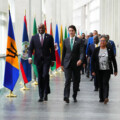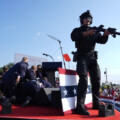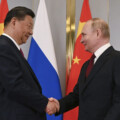Iran’s weekend attack on Israel, featuring over 300 projectiles, including drones, cruise missiles, and ballistic missiles, was largely thwarted, with only a handful of missiles slipping past Israeli defence systems to hit their mark. Is this attack, launched in retaliation for a recent Israeli attack at an Iranian embassy in Damascus, merely a face-saving response by Iran or the first strike in a larger salvo to come? And what is the risk of this conflict spiralling into a wider regional war? We gathered some of The Hub’s top foreign policy experts to offer their immediate reactions to the attack and discuss what could come next.
Israel emerges unscathed—for now
By Howard Anglin
After a tense Saturday night, as the sun rose on an unscathed Israel, three theories of what just happened began to take shape.
The first school says that Iran’s attack was a serious attempt to do real damage to Israel. This theory points to the sheer size and variety of munitions fired at Israel, which tested the limits of the Iron Dome. Only the scrambled assistance of the United States and the United Kingdom and the (perhaps unexpected) cooperation of Jordan and Saudi Arabia prevented a devastating tragedy. Iran really did try but failed, thanks to Israeli technology, Arab/American support, and, perhaps, Iranian weakness.

The second school believes Iran’s bombardment was for show and not meant to do real damage. Face-saving sabre-rattling. This theory cites Iran’s telegraphing of its attack for days and its announcement that slow-moving drones and missiles were in the air hours before they would arrive (i.e., the opposite of Hamas’s brutally successful surprise attack on October 7th). According to this theory, Iran’s attack was the minimum expected response to Israel’s killing of senior IRGC officials in Damascus, which was why it hit Israel directly and not through one of its proxies.
Finally, there is the (slightly more fringe) school of thought that thinks this was a probing attack designed to test and deplete the capacity of Iron Dome. According to this theory, Iran will use the lessons learned last night to plan future aerial assaults, either directly or via Hezbollah, to overwhelm Israel’s air defence systems.
For what it’s worth, on the basis of woefully imperfect information and much speculation, I come down somewhere between the first two theories. The attack was large (300+) and complex enough (drones, cruise missiles, and ballistic missiles) that Iran could reasonably have expected it to do real damage while being partially intercepted (but not 99 percent, as blessedly happened). And if I had to rank the likelihood of these theories, I would say it is: 1, 2, 3. But from the point of view of planning and preparedness, Israel and her allies and friends need to assume the worst: 3, 2, 1…
The night’s good news came in the welcome novelty of open support for Israel from Jordan and Saudi Arabia. Even if their motivation is of the “the enemy of my enemy” variety, that is more friendship than Israel has known in the region since its founding. Israel may still be surrounded on three sides by Iranian proxies, but Iran is waking up today to the reality that, between Israel, Saudi Arabia, Jordan, and American assets in the Gulf and Turkey, it is also now partially encircled.
The strategic environment has changed
By Joe Varner
It is dangerous to draw lessons or observations so close to a major event, but with a degree of understatement the Middle East strategic environment changed this weekend in three ways.
First, Iran’s attack using three hundred drones, cruise, and ballistic missiles was a major deviation from Iranian military doctrine. Iranian doctrine since the Iran-Iraq War (1980-1988) which was very painful has centred on avoiding direct conflict with an opponent while maintaining that conventional power and using proxy militias to do Tehran’s dirty work for them along with the IRGC Quds Force.
Something changed significantly for Iran on April 1st with the loss of two brigadiers of the IRGC in an Israeli attack on a diplomatic facility in Damascus. The commander-in-chief of the IRGC, General Hossein Salami, said, “We have adopted a new equation with the Zionist entity, which is to respond to any aggression from its side directly from Iranian territory.” In real terms, Iran is signalling to Israel that the gloves have come off. This represents a clear change in how Iran uses force.
Second, we just witnessed how Israel’s integrated air defence system, the most advanced in the world backed up with modern fighters and warships with advanced air defences from Israel’s allies, blunted the Iranian strikes, including the largest drone swarm attack in history. The Israeli air defence is very effective—but not perfect. Some of Iran’s Medium Range Ballistic Missiles (MRBM), key to any future Iranian nuclear attack, were let through and did hit an Israeli air base in the southern part of the country.
Right now, the Israeli systems prioritise these missiles if they are heading at population centres and they destroy them in space. That will have to change given that Iran is a few weeks out from having the material for three nuclear devices. Any nuclear strike on Israel would be deadly and destructive. Iran attacked Pakistani territory some weeks ago with ballistic missiles and has now done the same in Israel, shattering the myth that countries don’t attack nuclear-armed countries with conventional arms. The opacity of Iranian defence decision-making, the stark change in Iranian doctrine, the uncertainty that the next MRBM to get through and strike Israeli territory might be nuclear-tipped—all these factors open Iran’s nuclear programme up to Israeli preemption.
Third, the reason Israel may push back from the table with Iran and call it a day is that for the first time, Israel was defended by Jordan and the Kingdom of Saudi Arabia, both of whom played active parts in Israel’s defence. On any level that is a major strategic victory in its rivalry with Tehran, and one that has consequences for the entire region.

Israel will have to respond
By Michael Bonner
If you want to understand Iran, you need to grasp two facts first.
First, Iran’s central position and numerous frontiers mean a tense amalgam of imperial ambition and insecurity. The Persian language and the Shiite religion can be found in sizeable groups throughout the Middle East and in Inner Asia. Iran is obliged to influence, and perhaps to dominate, them. Similarly, Iran’s own domestic minorities are also found in quantity outside its borders, and so Iran is ever wary of trouble spilling over its borders.
Second, Iran can ill afford a direct conflict with any of its neighbours. It has a long history of miscarrying dreadfully in this manner. The last time it was tried was the Iran-Iraq War from 1980 to 1988. The results were an inconclusive outcome and a huge Iranian death toll.
Put those facts together, and you will see why Iran (a) meddles in its near-abroad, (b) has a penchant for proxies, missiles, and drones, and (c) inveighs most vehemently against distant countries like the USA, Britain, and Israel which have no natural interest in harming Iran.
And yet, Iran has its hawks who grow louder and crazier as the Khomeinist regime falters. The slow, much-publicised drone-and-missile demonstration was meant to appease them and avoid further conflict. We now await Israel’s reaction. The worst outcome would be one that strengthens the hawks by justifying their anti-Israel paranoia, so a direct hit on Iran is out of the question. If necessary, Israel can disarm the hawks by retaliating on their proxies throughout the Middle East: a potential distraction from operations in Gaza, but one that the Netanyahu government may find impossible to avoid.
The Trudeau government should immediately end its arms embargo of Israel
By Sean Speer
The underlying fallacy behind the Trudeau government’s suspension of supplying weapons and other military equipment to Israel was on display this past weekend when Israel found itself under an air attack carried out by Iran.
The drone and missile attack demonstrated what ought to have been clear since October 7: Israel isn’t just fighting a war against Hamas. Its enemies in the region are working together with coordination and funding coming from the Iranian regime.
Yet so much of the political discourse over the six months has framed the conflict as somehow between Israel and Palestinian civilians. As Canadian-Israeli journalist Matti Friedman wrote over the weekend:
This information campaign is as critical to Israel’s enemies as the physical war, because it erodes the Western support that Israel needs to win and survive. Its successful execution has turned a jihadi war against the Jewish minority enclave in the Middle East into a story about Jewish oppression and even “genocide” of Palestinians, a story that has become the focus of the increasingly deranged discourse in the liberal West.
The NDP motion on the post-October 7 conflict, which passed with the Trudeau government’s support in late March, was shot through with this type of thinking. It’s not obvious whether it ultimately reflects foreign policy naivete, motivated reasoning, or a combination of both. But the outcome is still the same: the Trudeau government’s policy vis-à-vis Israel has come to chiefly understand the source of the attack and the subsequent conflict in terms of the historic tensions between the Israeli state and the Palestinian people.
Put differently: to the extent the prime minister has outsourced his Middle East policy to the NDP and the progressive wing of his own party, he’s intentionally or unwittingly come to apply an oppressed-oppressor framework to guide his policy actions.
The government’s decision to halt weapons exports to Israel is a good (or bad) example. If one thinks narrowly about the conflict through an asymmetrical lens between Israel and the Gazans, then you might reach the conclusion that ending arms supplies to the powerful protagonist is an act of justice. If however you understand that Israel is facing multiple threats that are being back and coordinated by the Iranians, then the just response ought to involve supporting one’s outnumbered ally in a time of great need.
Conservative Party leader Pierre Poilievre has understood this point since the October 7 attacks. He’s consistently laid the ultimate blame for the attacks on the Iranians. As he’s put it: “[The] Palestinian people have been made by the Iranian regime and other dictators in the regime, in the region, into a chess piece in an evil chess game.”
This week’s air attacks launched from Tehran prove Poilievre is right and the prime minister is wrong. The latter can fix his mistake by immediately reversing his government’s arms embargo of Israel.
Recommended for You

Geoff Russ: A future Conservative government must fight the culture war, not stand idly by

David Mulroney: Foreign Minister Joly, Xi Jinping’s China doesn’t do ‘dialogue’

Amal Attar-Guzman: Canada’s global leadership is waning. Why not expand our influence closer to home?

Political leader assassination attempts are on the rise worldwide after years of decline










